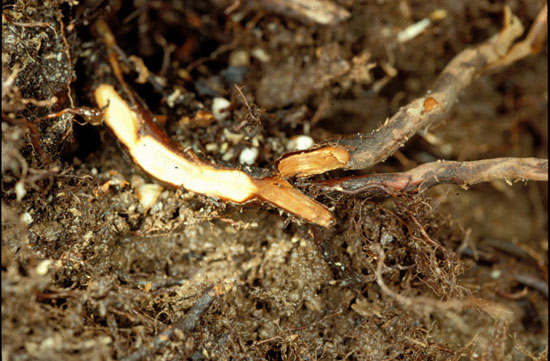Issue 13, July 31, 2009
Rhododendron Root Rot
It has been said that the two major hurdles to growing healthy rhododendrons in Illinois are clay soil and high pH levels of the soil. Rhododendrons thrive in acidic, well-drained soil. To make matters worse, Phytophthora root rot is a common disease on rhododendrons in wet sites.
Phytophthora species are considered to be soil-borne pathogens and can remain dormant in the soil for many years until conditions are conducive for infection. Phytophthora species produce a spore that requires water for movement, so it follows that these diseases are favored by wet conditions. Phytophthoras are water molds that attack susceptible plant hosts in times of wet weather or on sites with poor drainage. Some attack above ground plant parts (foliar Phytophthoras), some attack at the soil line, and some are root pathogens.
Phytophthora root rot occurs on rhododendrons throughout Illinois. Initially the leaves have a dull green cast. This is followed by wilting, rolling of the leaves (see first image), and lack of new growth. Roots of infected plants are reddish brown. Healthy roots should be white or should at least have white root tips. The second image shows healthy roots on the left and infected roots on the right. 2009 has certainly been conducive to infection.


Phytophthora root rot kills roots, thereby inhibiting water and nutrient absorption. Any factor that injures roots could produce similar symptoms. Lookalike problems might include flooding, drought, mechanical or chemical injury to roots, compaction, exposure of the crown, improper site preparation, or alkaline sites. For details on this disease, consult RPD No. 664, Phytophthora Root Rot or Wilt of Rhododendron and Azaleas in the Midwest.
If you suspect a Phytophthora infection, the University of Illinois Plant Clinic can test rhododendron roots using an enzyme-linked immunosorbent assay (ELISA), which allows for quick detection of the pathogen. The test takes one day in the lab and the cost is $25.00. ELISA tests work best with live, symptomatic tissue. In the case of rhododendron root rot, submit fresh, symptomatic roots in a plastic bag.
You will not be able to save infected plants, but proper identification of the problem can go a long way in preventing spread to other rhododendrons. Since poorly drained soils allow disease development even in some resistant rhododendrons, proper soil preparation and good drainage are keys to disease control. Resistant varieties are available but even those will not thrive if soil conditions are poor. Chemical drenches are available for commercial growers to help prevent disease spread in the planting. Products are listed in the Illinois Commercial Landscape and Pest Management Handbook. There are no systemic products available in home grower quantities. Carefully inspect any plant material that you purchase or move to your landscape.--Nancy Pataky
Author:
Nancy Pataky